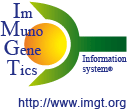Definition of the FR-IMGT and CDR-IMGT regions
The definition of the FR-IMGT and CDR-IMGT regions of IG and TR is based on the IMGT unique numbering for all IG and TR V-REGIONs of all species: interest for structure and evolution and, for rearranged CDR3-IMGT and for FR4-IMGT, on the IMGT unique numbering for V-DOMAIN and V-LIKE-DOMAIN.
Overview
- FR1-IMGT: Positions 1 to 26 (with 1st-CYS 23)
- CDR1-IMGT: Positions 27 to 38 (the longest CDR1-IMGT have 12 amino acids)
- FR2-IMGT: Positions 39 to 55 (with CONSERVED-TRP 41)
- CDR2-IMGT: Positions 56 to 65 (the longest CDR2-IMGT have 10 amino acids)
- FR3-IMGT: Positions 66 to 104 (with 2nd-CYS 104)
- CDR3-IMGT
- for germline V-GENEs: Positions 105 to 116 (the longest germline CDR3-IMGT have 12 amino acids)
- for rearranged V-J-GENEs or V-D-J-GENEs and corresponding cDNAs: Positions 105 to 117 (position preceding J-PHE or J-TRP 118) with gaps at the top of the loop for rearranged CDR3-IMGT less than 13 amino acids, or with additional positions 112.1, 111.1, 112.2, 111.2, etc. for rearranged CDR3-IMGT more than 13 amino acids.
- FR4-IMGT: for rearranged V-J-GENEs or V-D-J-GENEs and corresponding cDNAs: Position 118 (J-PHE or J-TRP) to 129 (the longest FR4-IMGT have 12 amino acids).
Anchor positions are positions which delimit the CDR-IMGT and which belong to the neighbouring FR-IMGT. They are shown in squares in the IMGT Colliers de Perles.
Anchor positions are:
- 26 and 39 for the CDR1-IMGT
- 55 and 66 for the CDR2-IMGT
- 104 and 118 for the CDR3-IMGT
| FR1-IMGT | CDR1-IMGT | FR2-IMGT | CDR2-IMGT | FR3-IMGT | For germline V-GENE (*) CDR3-IMGT |
For rearranged V-J-GENEs and V-D-J-GENEs |
||
| Germline CDR3-IMGT | Rearranged CDR3-IMGT | FR4-IMGT | ||||||
| Amino acid numbering |
1 --> 26 (C 23) |
27 --> 38 | 39 --> 55 (W 41) |
56 --> 65 | 66 --> 104 (C 104) |
105 --> 116 | 105 --> 117 (112.1, 111.1, 112.2, 111.2, etc.) |
118 --> 129 |
| Number of amino acids |
25-26 aa | 5-12 aa | 16-17 aa | 0-10 aa | 36-39 aa | 2-12 aa | 2-13 aa (more than 13 aa) |
10-12 aa |
(*) + 0, 1 or 2 nucleotide(s) before the heptamer.
Note that positions of the codons (or amino acids) in the rearranged CDR3-IMGT are not equivalent to those in the germline CDR3-IMGT, and cannot therefore be directly compared.
FR-IMGT regions
- The FR1-IMGT region of IG and TR comprises positions 1 to 26 (25-26 amino acids, depending on the V-GENE group or subgroup). 1st-CYS is at position 23.
- The FR2-IMGT region of IG and TR comprises positions 39 to 55 (16-17 amino acids). CONSERVED-TRP is at position 41.
- The FR3-IMGT region of IG and TR comprises positions 66 to 104 (36-39 amino acids, depending on the V-GENE group or subgroup). 2nd-CYS is at position 104.
- The FR4-IMGT region found in rearranged IG and TR V-J-GENEs and V-D-J-GENEs and corresponding cDNAs comprises positions 118 (J-PHE or J-TRP 118) to 129 (10-12 amino acids, depending on the J-REGION length).
CDR-IMGT regions
- The CDR1-IMGT region of IG and TR comprises positions 27 to 38 (5-12 amino acids, depending on the V-GENE group or subgroup).
The longest CDR1-IMGT have 12 amino acids. For shorter CDR1-IMGT, less than 12 amino acids, gaps are created (missing positions, hatched in Collier de Perles, or not shown in structural data representation).
Example: in a CDR1-IMGT with 5 amino acids, positions 27 to 31 are present, positions 32 to 38 are missing.
The unique concept of "CDR1-IMGT" replaces the diverse definitions and delimitations of the "CDR1", "H1 loop" and "L1 loop" found in the literature. For detailed information, see CDR1-IMGT Correspondence between numberings for CDR of different lengths (horizontal display). - The CDR2-IMGT region of IG and TR comprises positions 56 to 65 (0-10 amino acids, depending on the V-GENE group or subgroup).
The longest CDR2-IMGT have 10 amino acids. For shorter CDR2-IMGT, less than 10 amino acids, gaps are created (missing positions, hatched in Collier de Perles, or not shown in structural data representation).
Example: in a CDR2-IMGT with 3 amino acids, positions 56 to 58 are present, positions 59 to 65 are missing.
The unique concept of "CDR2-IMGT" replaces the diverse definitions and delimitations of the "CDR2", "H2 loop" and "L2 loop" found in the literature. For detailed information, see CDR2-IMGT Correspondence between numberings for CDR of different lengths (horizontal display). -
The CDR3-IMGT region of germline IG and TR V-GENEs comprises position 105 to 116 (2-12 amino acids,
depending on the V-GENE group or subgroup).
The 3' end of germline CDR3-IMGT is limited by the V-HEPTAMER.
The longest germline CDR3-IMGT have 12 amino acids. For shorter germline CDR3-IMGT, positions are missing.
Example: for a germline CDR3-IMGT with 2 amino acids, only positions 105 and 106 are present.
For correspondence with the literature, see CDR3-IMGT Correspondence between numberings for CDR of different lengths (horizontal display).The CDR3-IMGT region of rearranged IG and TR V-J-GENEs or V-D-J-GENEs and corresponding cDNAs comprises positions 105 to 117 (position preceding J-PHE or J-TRP 118) with additional positions (112.1, 111.1, 112.2, 111.2, 112.3, 111.3, etc., at the top of the CDR3-IMGT loop), for rearranged CDR3-IMGT more than 13 amino acids (IMGT unique numbering for V-DOMAIN and V-LIKE-DOMAIN).
For rearranged CDR3-IMGT less than 13 amino acids, gaps are created at the top of the loop, in the following order 111, 112, 110, 113, 109, 114, etc (IMGT unique numbering for V-DOMAIN and V-LIKE-DOMAIN).
The unique concept of "CDR3-IMGT" replaces the diverse definitions and delimitations of the "CDR3", "H3 loop" and "L3 loop" found in the literature.
CDR-IMGT sequence and structural data comparison
- The CDR-IMGT length (in number of amino acids or codons, that is in number of occupied positions)
is a crucial and original concept of IMGT-ONTOLOGY.
The CDR-IMGT lengths characterize the IG and TR V-REGIONs of the germline genes and the V-DOMAINs of the rearranged genes,
cDNAs and proteins.
The length of the three CDR-IMGT, in number of amino acids (or codons), is shown into brackets and separated by dots.
Examples:- Human germline IGKV1-6 [6.3.7] means that in the V-REGION of the human germline IGKV1-6 gene, the CDR1-IMGT, CDR2-IMGT and CDR3-IMGT have a length of 6, 3 and 7 codons, respectively (Collier de Perles).
- Human TcR A6 V-BETA [5.6.14] means that in the V-BETA DOMAIN of the human T cell receptor A6, the CDR1-IMGT, CDR2-IMGT and CDR3-IMGT have a length of 5, 6 and 14 amino acids, respectively (Collier de Perles). For other examples, see Classification by CDR-IMGT lengths in Proteins with known 3D structures.
- Sequence comparisons of CDR-IMGT of the same length can be done directly using the IMGT unique numbering. For example, the codon or amino acid at position 26 can be compared to all codons or amino acids at the same position for all CDR1-IMGT of the same length. This also holds for structural data comparison and for statistical analysis, position per position.
-
For sequence and structural data comparisons of CDR-IMGT of different lengths and for statistical
analysis, position per position, gaps are created at the top of the loop (with an equal number of codons or amino
acids on both sides if the CDR-IMGT length is an even number of codons or amino acids, or with one more amino acid in the
left part of the loop if the CDR-IMGT length is an odd number).
However, these gaps are not stored because they depend on the length of the longest CDR-IMGT in the set of analysed sequences, and on the type of analysis performed or results provided.
Amino acids (or codons) of CDR1-IMGT or CDR2-IMGT less than 12 or 10 amino acid long, respectively, can also be "moved" inside the limits of the corresponding CDR-IMGT, and gaps created on both sides of the occupied positions (equal number of gaps on both sides if even number, or one more gap on the right if odd number).
These gaps are not stored. Indeed, amino acid (or codon) position in the IMGT unique numbering and CDR-IMGT lengths provide sufficient information to correctly position any amino acid (or codon) for any CDR-IMGT sequence and structural data comparison.



